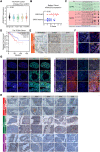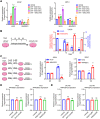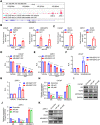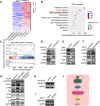Androgen deprivation restores ARHGEF2 to promote neuroendocrine differentiation of prostate cancer
- PMID: 36335093
- PMCID: PMC9637107
- DOI: 10.1038/s41419-022-05366-8
Androgen deprivation restores ARHGEF2 to promote neuroendocrine differentiation of prostate cancer
Erratum in
-
Correction: Androgen deprivation restores ARHGEF2 to promote neuroendocrine differentiation of prostate cancer.Cell Death Dis. 2023 Oct 2;14(10):647. doi: 10.1038/s41419-023-06051-0. Cell Death Dis. 2023. PMID: 37783705 Free PMC article. No abstract available.
Abstract
Androgen receptor (AR) plays an important role in the progression of prostate cancer and has been targeted by castration or AR-antagonists. The emergence of castration-resistant prostate cancer (CRPC) after androgen deprivation therapy (ADT) is inevitable. However, it is not entirely clear how ADT fails or how it causes resistance. Through analysis of RNA-seq data, we nominate ARHGEF2 as a pivotal androgen-repressed gene. We show that ARHGEF2 is directly suppressed by androgen/AR. AR occupies the enhancer and communicates with the promoter region of ARHGEF2. Functionally, ARHGEF2 is important for the growth, lethal phenotype, and survival of CRPC cells and tumor xenografts. Correspondingly, AR inhibition or AR antagonist treatment can restore ARHGEF2 expression, thereby allowing prostate cancer cells to induce treatment resistance and tolerance. Overall, our findings provide an explanation for the contradictory clinical results that ADT resistance may be caused by the up-regulation of ARHGEF2 and provide a novel target.
© 2022. The Author(s).
Conflict of interest statement
The authors declare no competing interests.
Figures






Similar articles
-
Restoration of the cellular secretory milieu overrides androgen dependence of in vivo generated castration resistant prostate cancer cells overexpressing the androgen receptor.Biochem Biophys Res Commun. 2016 Jul 22;476(2):69-74. doi: 10.1016/j.bbrc.2016.05.058. Epub 2016 May 12. Biochem Biophys Res Commun. 2016. PMID: 27179779
-
Downregulation of Dipeptidyl Peptidase 4 Accelerates Progression to Castration-Resistant Prostate Cancer.Cancer Res. 2018 Nov 15;78(22):6354-6362. doi: 10.1158/0008-5472.CAN-18-0687. Epub 2018 Sep 21. Cancer Res. 2018. PMID: 30242112 Free PMC article.
-
Targeting the androgen receptor signaling pathway in advanced prostate cancer.Am J Health Syst Pharm. 2022 Jul 22;79(15):1224-1235. doi: 10.1093/ajhp/zxac105. Am J Health Syst Pharm. 2022. PMID: 35390118 Review.
-
Androgen receptors in hormone-dependent and castration-resistant prostate cancer.Pharmacol Ther. 2013 Dec;140(3):223-38. doi: 10.1016/j.pharmthera.2013.07.003. Epub 2013 Jul 13. Pharmacol Ther. 2013. PMID: 23859952 Review.
-
Expansion of mouse castration-resistant intermediate prostate stem cells in vitro.Stem Cell Res Ther. 2022 Jul 15;13(1):299. doi: 10.1186/s13287-022-02978-x. Stem Cell Res Ther. 2022. PMID: 35841025 Free PMC article.
Cited by
-
New insights into molecular signaling pathways and current advancements in prostate cancer diagnostics & therapeutics.Front Oncol. 2023 Aug 17;13:1193736. doi: 10.3389/fonc.2023.1193736. eCollection 2023. Front Oncol. 2023. Retraction in: Front Oncol. 2023 Dec 07;13:1343833. doi: 10.3389/fonc.2023.1343833. PMID: 37664036 Free PMC article. Retracted. Review.
-
Transformation to Neuroendocrine Phenotype in Non-Small-Cell Lung Carcinoma: A Literature Review.Int J Mol Sci. 2025 May 26;26(11):5096. doi: 10.3390/ijms26115096. Int J Mol Sci. 2025. PMID: 40507907 Free PMC article. Review.
-
Dihydrotestosterone Augments the Angiogenic and Migratory Potential of Human Endothelial Progenitor Cells by an Androgen Receptor-Dependent Mechanism.Int J Mol Sci. 2024 Apr 29;25(9):4862. doi: 10.3390/ijms25094862. Int J Mol Sci. 2024. PMID: 38732080 Free PMC article.
-
Transcriptome analysis reveals the genetic basis underlying the formation and seasonal changes of nuptial pads in Rana chensinensis.BMC Genomics. 2024 Dec 30;25(1):1254. doi: 10.1186/s12864-024-11176-3. BMC Genomics. 2024. PMID: 39736519 Free PMC article.
-
Unraveling the biological link between diabetes mellitus and prostate cancer: Insights and implications.World J Diabetes. 2024 Jun 15;15(6):1367-1373. doi: 10.4239/wjd.v15.i6.1367. World J Diabetes. 2024. PMID: 38983816 Free PMC article.
References
Publication types
MeSH terms
Substances
LinkOut - more resources
Full Text Sources
Molecular Biology Databases
Research Materials

